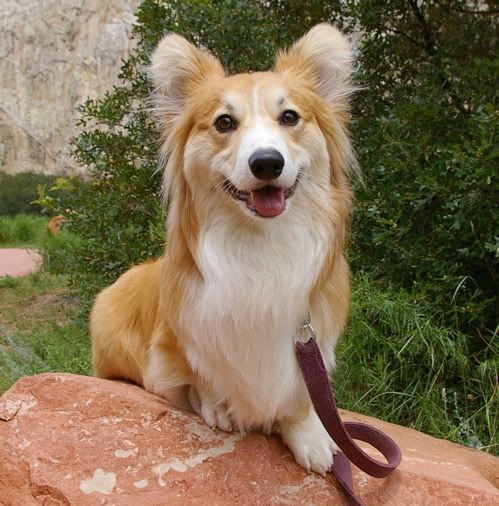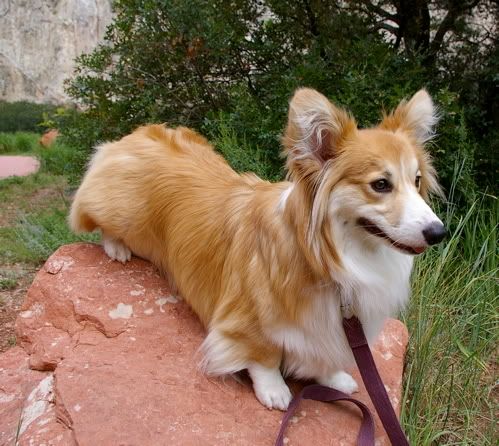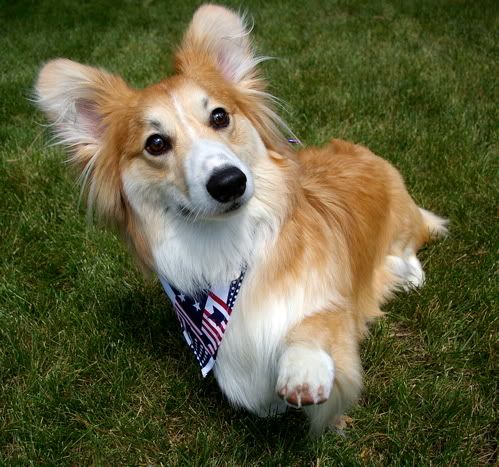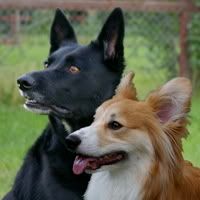There are several different dog behaviors that are considered "rude" in the human world that can be prevented easily at an early age. I just wanted to share some methods that I have used.
-Jumping Up
One of the easiest and most effective ways to prevent a dog from learning to jump up is simply to ignore from the beginning. If the dog jumps up, pretend he doesn't exist. Take your hands away, and look somewhere else. Stand up if you have to. What the dog is looking for is attention, so don't give in. Even telling the dog "NO" is attention.
As soon as the dog puts all four feet back on the ground, give lots of praise. He will quickly learn that jumping up gets absolutely no reaction from you, and isn't worth trying, but if he has all four feet on the ground, he gets all kinds of love and attention! Teaching the dog not to jump up can take weeks to months from puppyhood if you are consistent.
-Chewing Inappropriate Objects
Two great methods for preventing chewing from becoming a bad habit is confining the dog when he's not being supervised, and catching him in the act of chewing so that you can trade the the wrong object for the right one.
Crating is a great way to prevent your dog from getting into things he shouldn't when you're not around. It can also prevent him from getting into dangerous situations, such as being tangled in wires, eating toxic things, and many other dangerous things young, untrained dogs tend to do when they're alone.
When the dog is out, and you catch him chewing on something he shouldn't, you can get his attention with a sharp "Ah, Ah!" or something similar. Try to get him to trade for the right object, such as a chew toy, by holding it up for him so that he stops chewing the inappropriate object and goes for the toy. When he lets go of the inappropriate object, you can also say "Trade ya!" before you let him have his toy. This exercise can also teach another valuable tool - trading for another object - which can help to prevent resource guarding in the future.
One other thing I must mention is that you should ALWAYS have lots of things for the dog to chew on, no matter what age he is! Dogs never just grow up and stop chewing. They need to chew throughout their lives.
Teaching a dog to chew on the RIGHT things can take a lot of time and consistency, but don't give up!
-Getting Into Trash
There is a VERY simple solution for this, and I don't understand why people refuse to do it - Get a covered trash can, or put your trash in a cabinet, or behind a gate or door where your dog cannot access it! Out of sight, out of mind!
-Excessive Barking
Play sessions are a great way to help prevent unwanted barking. While you are playing with your dog, be it tug or fetch, or whatever his favorite game is, pay attention to how loud he's being. If he starts barking, you can immediately get up, put the toy out of reach, and end the play session for a few minutes. This is a very quick and humane way to teach the dog that if he starts barking, it causes you to quit playing with him. It really does help to curb a lot of unnecessary barking in the long run.
All articles on this blog are written by Victoria Steen unless otherwise stated. They are NOT to be redistributed.
Monday, July 30, 2007
Potty Training
Before other training is covered, the dog should be potty trained or in the process of being potty trained. You can do this while you train other things, but it must be done, or your house will be a mess! I'm listing several different methods that are used to potty train, with a description of each. Some I recommend. Others I recommend avoiding, but I will include them here anyway to explain why I dislike them.
Contents
~~~~~~~~~~~
*Crate Training
*Tethering
*Just Plain Supervision
*Paper/Puppy Pad Training
*Follow-up on Potty Training
-Crate Training
There are several suggested methods of potty training, but I find that the most effective is crate training. Crate training is a method where you confine the dog to a crate/kennel when it's not being supervised so that it does not have a chance to have an accident on the floor. Using this method, the dog will quickly learn that outside is the place to go.
First off, you will need a crate for the dog. A crate should be the appropriate size for the dog (only big enough for the dog to stand up, turn around, and lie down). It's easiest to get the dog used to the crate before confining it. Put treats or toys in the crate and encourage the dog to go into it without closing the door. Show your dog that the crate is a good place to be. While you're introducing the crate, you will want to supervise the dog a lot since it's not actually being confined.
When you finally close the door, put in a toy like a Kong or favorite chew toy to keep the dog busy. You can also feed the dog its meals in the crate. Only keep the door closed for 5-10 minutes and praise profusely while the dog is in the crate. Repeat this many times, and gradually leave the door closed for longer periods of time. Introducing the crate shouldn't take more than a day or so. Remember to put distractions in the crate! It makes it easier. NEVER give a dog attention for crying/whining in the crate. This means even telling the dog to be quiet, giving up and letting the dog out, etc.
Once the dog is used to being confined, the real training starts. Any time the dog is not being closely supervised, it should be crated. As soon as it's let out of the crate, it should be taken straight outside to potty. No eating, drinking, or playing till the dog goes potty! When the dog does its business outside, praise PROFUSELY (as a friend of mine said once, if you don't look totally insane to all passers-by while praising, you're not doing it right). Then it is okay to play inside or out and eat/drink for the next half hour or so. Once play is done, crate the dog again. If the dog ate or drank while it was out, maybe take it outside to potty once more before it's crated.
Dogs are actually very clean creatures, and a dog will learn very quickly that it does not want to soil where it sleeps/lies. Once you are sure that there won't be any accidents in the crate, you can put some soft bedding down like a blanket or crate mat. Always crate the dog when you are not home, but remember not to leave it crated for more than a few hours (puppies for even less). You might want to give a friend or family member a spare house key so that if you are gone for too long, they can let the dog out to potty while you are away.
In several weeks to a few months (depending on the dog), times between crating the dog should increase until you really shouldn't have to crate them at all unless you leave the house. After the dog is fully potty trained using this method, it's up to you whether or not you continue to crate them when you leave the house. Some people continue to do it just for the dog's safety.
-Tethering
Tethering is a method in which you tie the dog to yourself, so it can't stray off someplace and have an accident. The dog will have to follow you around the house and stay with you, and thus, can't sneak off. Most people loop the lead around an arm or leg, or buy a special lead that hooks to a belt. This method also involves keeping a close eye on the dog and watching for signs that the dog needs to go out, such as pacing, turning in circles, sniffing the floor more than usual, etc. If you spot these signs, immediately carry or lead the dog outside where it can do its business. When the dog goes, praise him profusely.
Using this method alone, you'll have to watch the dog like a hawk to prevent any accidents. Remember, if the dog doesn't have any chances to have accidents, it will not become accustomed to going in the house.
-Just Plain Supervision
This method is just as the title sounds. Basically, the dog is not crated or made to be near you. It might be locked out of certain areas of the house, but it's not really confined. You have to watch the dog constantly, like a hawk, to make sure there are no accidents. If the dog shows signs of having to potty (pacing, turning in circles, sniffing around more than usual), immediately carry or lead it outside to do its business. Once it goes, praise profusely. This method requires the MOST supervision when used alone, and is very difficult for the vast majority of people, because we are only human, and can become distracted and forget we are watching the dog. Distractions are the cause of most potty accidents in the house. Therefore, I do not recommend the use of this method alone. It is best used in conjunction with crate training or tethering.
-Paper/Puppy Pad Training
In the world of dog training, there are great methods of training, and then there are horrible methods. I'm listing this method as the worst, least-effective potty training method I know of.
Basically, you teach the dog to potty on newspaper or specially-made puppy pads. Usually, the dog is confined to a certain area, like the kitchen or bathroom, and newspapers are spread throughout the whole area, or a puppy pad is put down (most have pheromones in them which attract the dog). The dog is encouraged to potty on these and is praised when it does, and quickly learns that it's supposed to potty on the paper or pad in the room. Once it has learned this, it is confined less and a pad or newspaper is kept down in certain parts of the house, which is where the dog goes.
Owners will sometimes continue putting down paper in the house throughout the dog's life (perhaps if they live in a small apartment), and I've also seen owners put puppy pads inside crates and allow the dog to go on it INSIDE the crate (NO! BAD owner *slaps with paper*) but ideally, when the dog has fully learned to go on the paper/pad, the owner will start to slowly move the paper/pad toward the door each day. Eventually, the paper/pad will be outside, so the dog will have to go outside to go on it. After this, the paper/pad is removed, and the dog will start going in the grass instead.
...Or this is how it's SUPPOSED to work. I strongly dislike this method, and here is why:
It teaches the dog that it is okay to potty inside the house
Once you move the paper/pad outside, you change the rules and the dog is no longer allowed to potty in the house. This confuses the heck out of the dog, resulting in accidents.
A large percentage of the time, the dog just doesn't catch on, either because the owner wasn't doing it right or the dog is just confused.
I find paper/puppy pad training to be a majorly outdated method of training, and I recommend that dog owners avoid it at all costs. However, SOMETIMES it works, and it's a common method still, so I did include it on the list.
Follow-up on Potty Training
~~~~~~~~~~~
-What To Do if There IS an Accident
If the dog does happen to have an accident inside, avoid any harsh punishments (hitting or ANY kind, screaming, scruffing, etc). Either give it no reaction when it goes inside, or choose a phrase to mark that the dog has made a mistake ("Nah uh! This goes outside!" etc.). Then quickly carry or lead the dog outside to finish. Praise it if it goes the rest of the way outside ("GOOOOOD potty!"). Harshly punishing a dog for accidents in the house can result in hard-to-fix psychological disorders such as coprophagy (the instance in which a dog eats its own excrement, in this case, out of the fear of punishment). It also doesn't teach the dog much else except that it's wrong to potty in front of you, and so instead, the dog will sneak off and potty where you're not watching.
Do's and Don'ts of Potty Training
NEVER crate a dog as punishment for ANYTHING, including potty accidents.
ALWAYS give loads of praise when the dog goes outside.
NEVER harshly punish a dog for accidents.
ALWAYS watch the dog closely if it's not confined.
NEVER put puppy pads in a crate.
ALWAYS let a dog out of a crate every few hours for attention.
ALWAYS take a dog potty after it eats/drinks/plays/sleeps/leaves the crate.
All articles on this blog are written by Victoria Steen unless otherwise stated. They are NOT to be redistributed.
Contents
~~~~~~~~~~~
*Crate Training
*Tethering
*Just Plain Supervision
*Paper/Puppy Pad Training
*Follow-up on Potty Training
-Crate Training
There are several suggested methods of potty training, but I find that the most effective is crate training. Crate training is a method where you confine the dog to a crate/kennel when it's not being supervised so that it does not have a chance to have an accident on the floor. Using this method, the dog will quickly learn that outside is the place to go.
First off, you will need a crate for the dog. A crate should be the appropriate size for the dog (only big enough for the dog to stand up, turn around, and lie down). It's easiest to get the dog used to the crate before confining it. Put treats or toys in the crate and encourage the dog to go into it without closing the door. Show your dog that the crate is a good place to be. While you're introducing the crate, you will want to supervise the dog a lot since it's not actually being confined.
When you finally close the door, put in a toy like a Kong or favorite chew toy to keep the dog busy. You can also feed the dog its meals in the crate. Only keep the door closed for 5-10 minutes and praise profusely while the dog is in the crate. Repeat this many times, and gradually leave the door closed for longer periods of time. Introducing the crate shouldn't take more than a day or so. Remember to put distractions in the crate! It makes it easier. NEVER give a dog attention for crying/whining in the crate. This means even telling the dog to be quiet, giving up and letting the dog out, etc.
Once the dog is used to being confined, the real training starts. Any time the dog is not being closely supervised, it should be crated. As soon as it's let out of the crate, it should be taken straight outside to potty. No eating, drinking, or playing till the dog goes potty! When the dog does its business outside, praise PROFUSELY (as a friend of mine said once, if you don't look totally insane to all passers-by while praising, you're not doing it right). Then it is okay to play inside or out and eat/drink for the next half hour or so. Once play is done, crate the dog again. If the dog ate or drank while it was out, maybe take it outside to potty once more before it's crated.
Dogs are actually very clean creatures, and a dog will learn very quickly that it does not want to soil where it sleeps/lies. Once you are sure that there won't be any accidents in the crate, you can put some soft bedding down like a blanket or crate mat. Always crate the dog when you are not home, but remember not to leave it crated for more than a few hours (puppies for even less). You might want to give a friend or family member a spare house key so that if you are gone for too long, they can let the dog out to potty while you are away.
In several weeks to a few months (depending on the dog), times between crating the dog should increase until you really shouldn't have to crate them at all unless you leave the house. After the dog is fully potty trained using this method, it's up to you whether or not you continue to crate them when you leave the house. Some people continue to do it just for the dog's safety.
-Tethering
Tethering is a method in which you tie the dog to yourself, so it can't stray off someplace and have an accident. The dog will have to follow you around the house and stay with you, and thus, can't sneak off. Most people loop the lead around an arm or leg, or buy a special lead that hooks to a belt. This method also involves keeping a close eye on the dog and watching for signs that the dog needs to go out, such as pacing, turning in circles, sniffing the floor more than usual, etc. If you spot these signs, immediately carry or lead the dog outside where it can do its business. When the dog goes, praise him profusely.
Using this method alone, you'll have to watch the dog like a hawk to prevent any accidents. Remember, if the dog doesn't have any chances to have accidents, it will not become accustomed to going in the house.
-Just Plain Supervision
This method is just as the title sounds. Basically, the dog is not crated or made to be near you. It might be locked out of certain areas of the house, but it's not really confined. You have to watch the dog constantly, like a hawk, to make sure there are no accidents. If the dog shows signs of having to potty (pacing, turning in circles, sniffing around more than usual), immediately carry or lead it outside to do its business. Once it goes, praise profusely. This method requires the MOST supervision when used alone, and is very difficult for the vast majority of people, because we are only human, and can become distracted and forget we are watching the dog. Distractions are the cause of most potty accidents in the house. Therefore, I do not recommend the use of this method alone. It is best used in conjunction with crate training or tethering.
-Paper/Puppy Pad Training
In the world of dog training, there are great methods of training, and then there are horrible methods. I'm listing this method as the worst, least-effective potty training method I know of.
Basically, you teach the dog to potty on newspaper or specially-made puppy pads. Usually, the dog is confined to a certain area, like the kitchen or bathroom, and newspapers are spread throughout the whole area, or a puppy pad is put down (most have pheromones in them which attract the dog). The dog is encouraged to potty on these and is praised when it does, and quickly learns that it's supposed to potty on the paper or pad in the room. Once it has learned this, it is confined less and a pad or newspaper is kept down in certain parts of the house, which is where the dog goes.
Owners will sometimes continue putting down paper in the house throughout the dog's life (perhaps if they live in a small apartment), and I've also seen owners put puppy pads inside crates and allow the dog to go on it INSIDE the crate (NO! BAD owner *slaps with paper*) but ideally, when the dog has fully learned to go on the paper/pad, the owner will start to slowly move the paper/pad toward the door each day. Eventually, the paper/pad will be outside, so the dog will have to go outside to go on it. After this, the paper/pad is removed, and the dog will start going in the grass instead.
...Or this is how it's SUPPOSED to work. I strongly dislike this method, and here is why:
It teaches the dog that it is okay to potty inside the house
Once you move the paper/pad outside, you change the rules and the dog is no longer allowed to potty in the house. This confuses the heck out of the dog, resulting in accidents.
A large percentage of the time, the dog just doesn't catch on, either because the owner wasn't doing it right or the dog is just confused.
I find paper/puppy pad training to be a majorly outdated method of training, and I recommend that dog owners avoid it at all costs. However, SOMETIMES it works, and it's a common method still, so I did include it on the list.
Follow-up on Potty Training
~~~~~~~~~~~
-What To Do if There IS an Accident
If the dog does happen to have an accident inside, avoid any harsh punishments (hitting or ANY kind, screaming, scruffing, etc). Either give it no reaction when it goes inside, or choose a phrase to mark that the dog has made a mistake ("Nah uh! This goes outside!" etc.). Then quickly carry or lead the dog outside to finish. Praise it if it goes the rest of the way outside ("GOOOOOD potty!"). Harshly punishing a dog for accidents in the house can result in hard-to-fix psychological disorders such as coprophagy (the instance in which a dog eats its own excrement, in this case, out of the fear of punishment). It also doesn't teach the dog much else except that it's wrong to potty in front of you, and so instead, the dog will sneak off and potty where you're not watching.
Do's and Don'ts of Potty Training
NEVER crate a dog as punishment for ANYTHING, including potty accidents.
ALWAYS give loads of praise when the dog goes outside.
NEVER harshly punish a dog for accidents.
ALWAYS watch the dog closely if it's not confined.
NEVER put puppy pads in a crate.
ALWAYS let a dog out of a crate every few hours for attention.
ALWAYS take a dog potty after it eats/drinks/plays/sleeps/leaves the crate.
All articles on this blog are written by Victoria Steen unless otherwise stated. They are NOT to be redistributed.
Friday, July 27, 2007
The Search is On!
Well, Shippo did fine being left with a stranger for 3 minutes! I'm so proud of him. Also, he impressed the heck out of the trainer at work with his coat and temperament. *Gloat* Now it's time to find a CGC Evaluator and take the test!! Wish me luck.
Tuesday, July 24, 2007
A Hike + More Work Towards CGC

On friday, I took Shippo for a nice hike at The Garden of the Gods, which ended up being FILLED with tourists. This ended up being a good opportunity to practice walking through a crowd of people, to see how he'd react. He did awesome! He stayed with me the whole time, no pulling or anything, and we were able to walk up to a few people who asked to pet him! We seemed to turn heads the whole time we were there, because I kept hearing people telling each other what a gorgeous dog he was lmao.


Then we got lost, because the maps there suck, so we walked around aimlessly till we found the exit again. When we were exiting the park, I heard somebody telling his group of people how he "potty trained" dogs by rubbing their noses in it, hitting the dog, and throwing it outside. It's hard to imagine that people are still using such outdated methods.
In other news, a co-worker of mine is a trainer, and she said to stop by Friday, so we can test Shippo and see how he reacts to being without me for 3 minutes - another crucial part of the CGC test. I couldn't imagine him reacting badly, but you never know I guess. More on that later...
Friday, July 6, 2007
Intro
Ok, it's time to start my dog training blog (great idea, Tebbs)! With this blog, I can record my training progress with my two dogs. First things first, here is a little info about me:
Name: Vicki (preferred name online is Cheetah)
Occupation: Crap job at Petsmart
Interests: Dog training, canine nutrition, photography
Favorite Trainers: Victoria Stilwell, Pat Miller
Dogs Sports/Activities Interested In: Agility, Flyball, Therapy, maybe Herding
~~~~~~~~~~~~~~~~~~~~~~
My Dogs:
Shippo, Male, 1.5-year-old Pembroke Welsh Corgi

Shippo came to me from a show breeder in Canada, whose bitch threw two fluffies in her litter. Fluffies are pet quality, but they sure are gorgeous, and I can still do everything else with him except conformation. I plan on doing agility, therapy work, and possibly flyball with Shippo.
~~~~~~~~~~~~~~~~~~~~~~
Eevee, Female, 7-year-old Border Collie Mix

Eevee came from the local Humane Society when she was 8 months old. She was dumped there because her previous owners were moving, and apparently didn't bother to find a place that allowed dogs. But that's okay, because otherwise I never would have found my heart dog! Eevee and I have been through a lot together.
~~~~~~~~~~~~~~~~~~~~~~
Name: Vicki (preferred name online is Cheetah)
Occupation: Crap job at Petsmart
Interests: Dog training, canine nutrition, photography
Favorite Trainers: Victoria Stilwell, Pat Miller
Dogs Sports/Activities Interested In: Agility, Flyball, Therapy, maybe Herding
My Dogs:

Shippo came to me from a show breeder in Canada, whose bitch threw two fluffies in her litter. Fluffies are pet quality, but they sure are gorgeous, and I can still do everything else with him except conformation. I plan on doing agility, therapy work, and possibly flyball with Shippo.

Eevee came from the local Humane Society when she was 8 months old. She was dumped there because her previous owners were moving, and apparently didn't bother to find a place that allowed dogs. But that's okay, because otherwise I never would have found my heart dog! Eevee and I have been through a lot together.
Subscribe to:
Posts (Atom)
